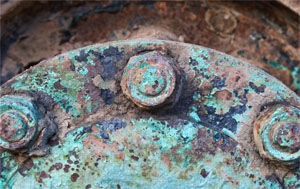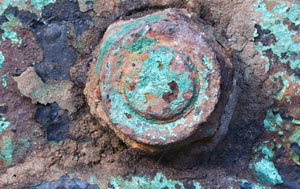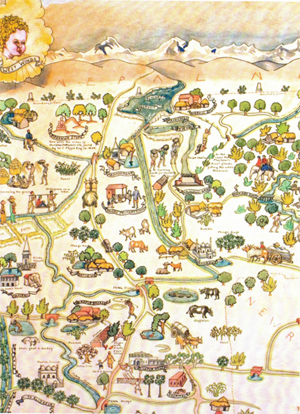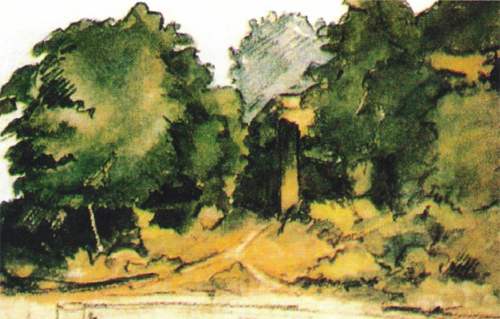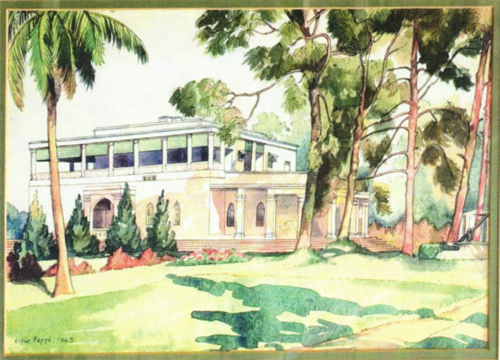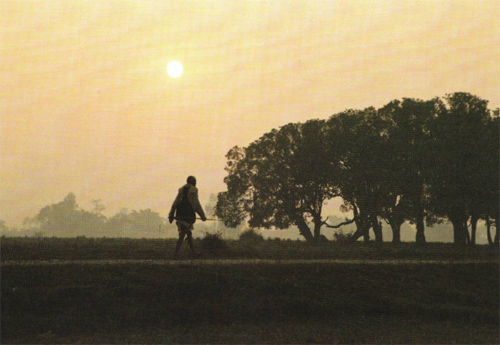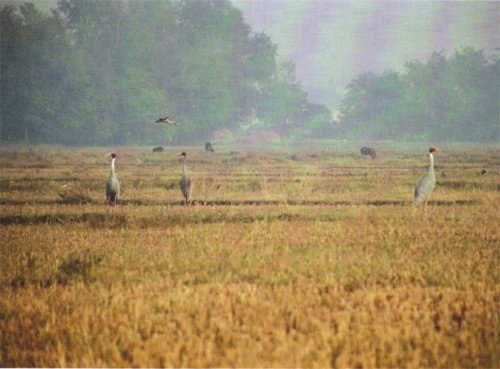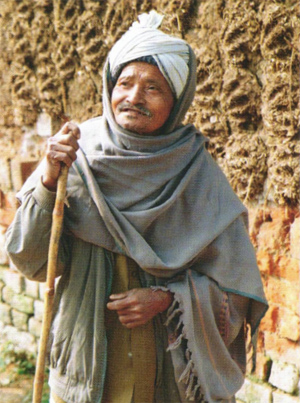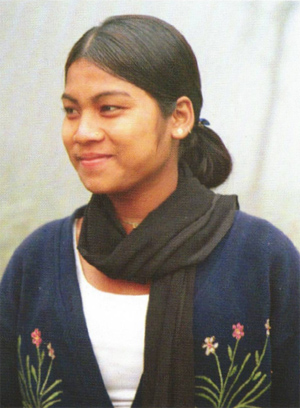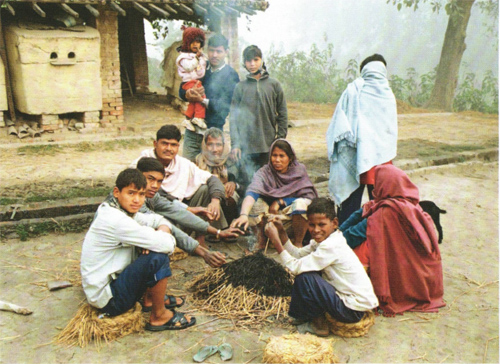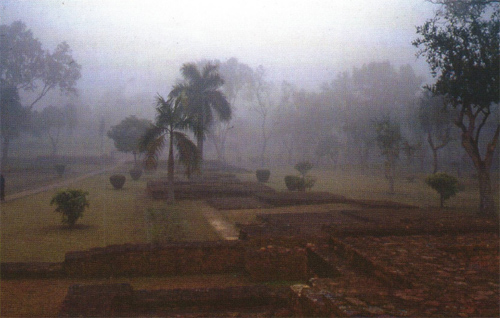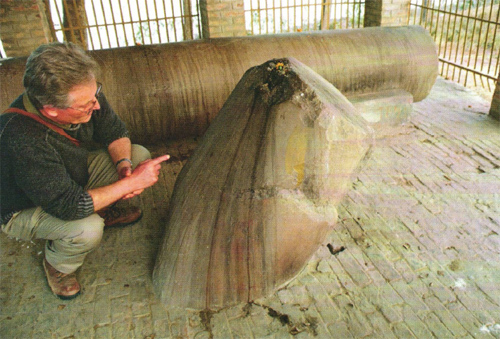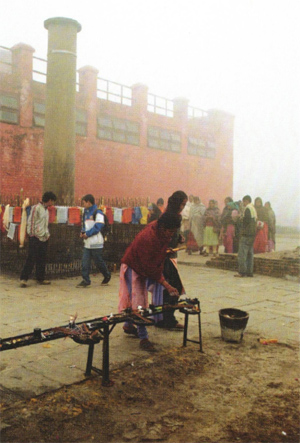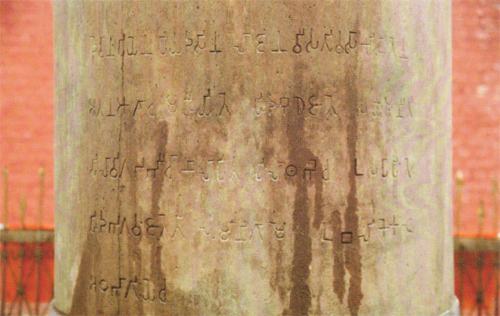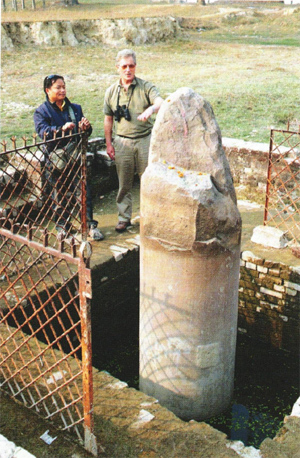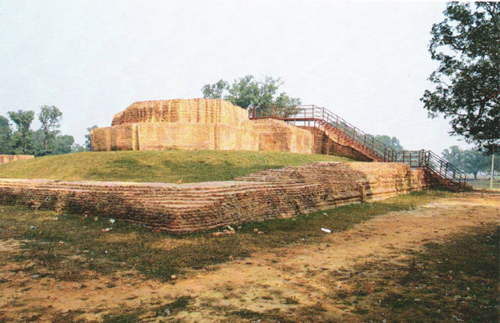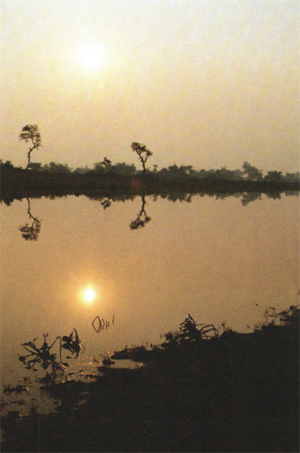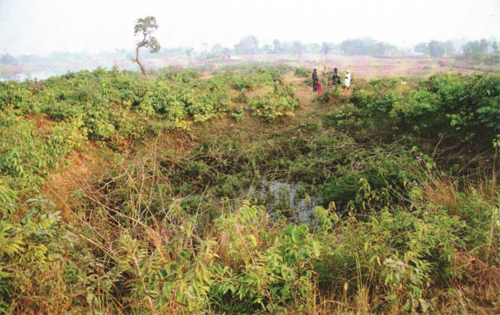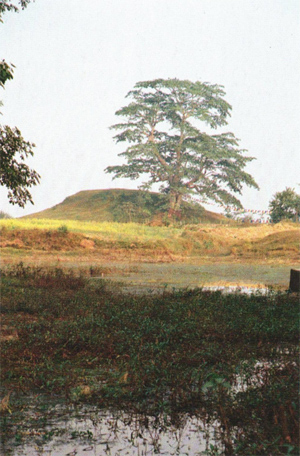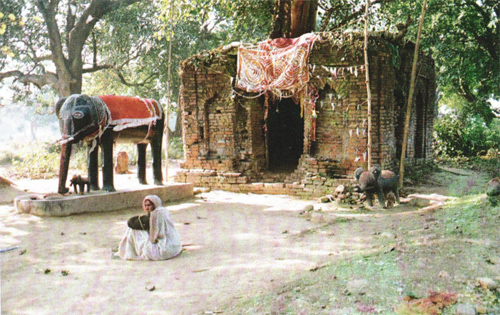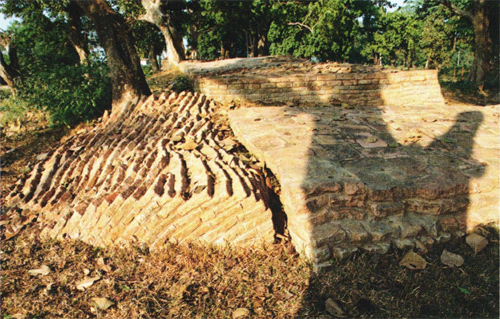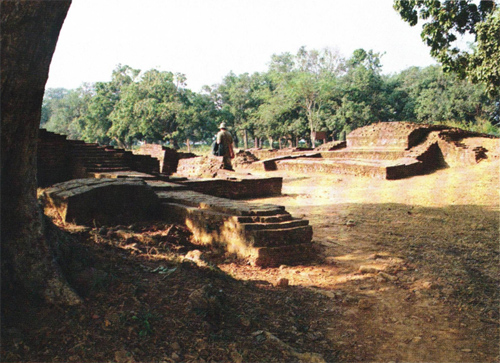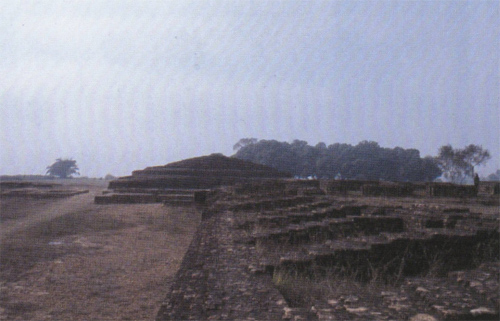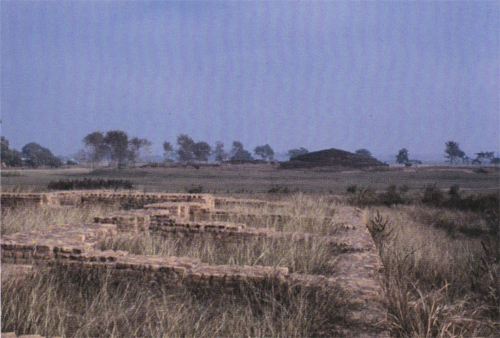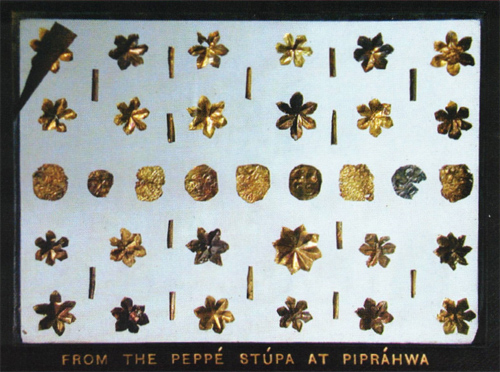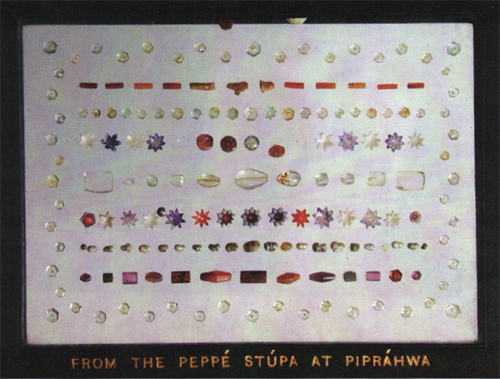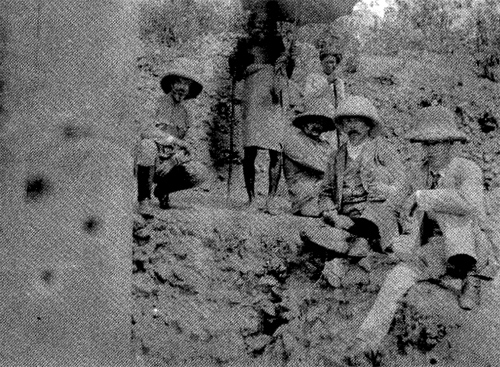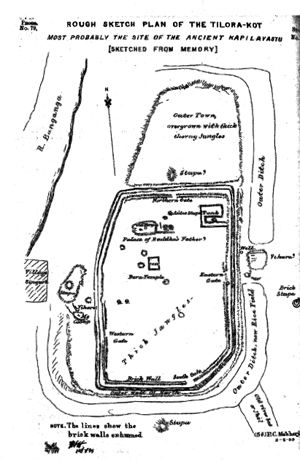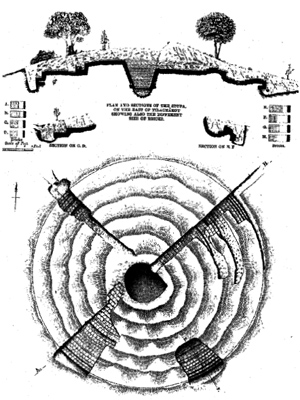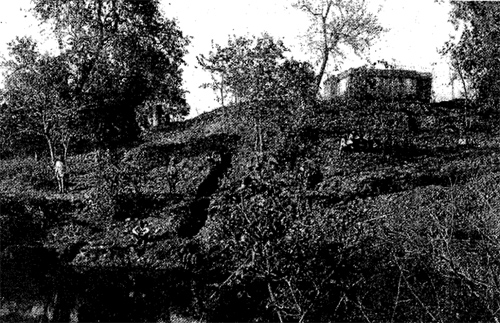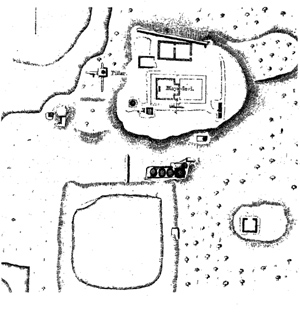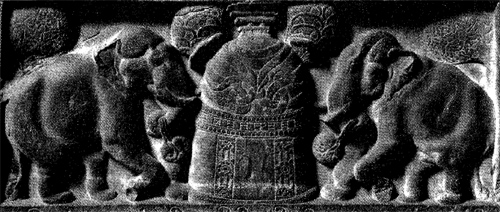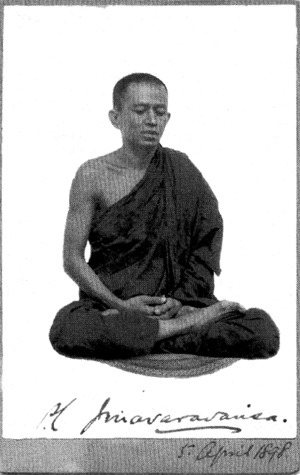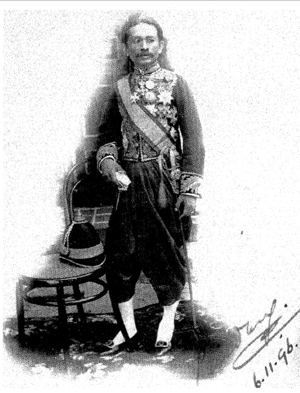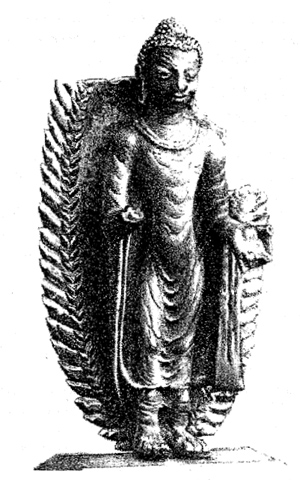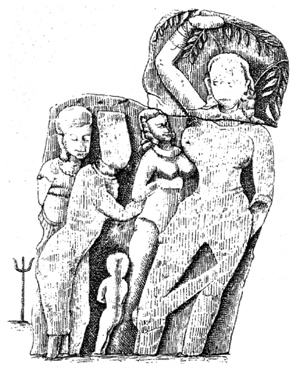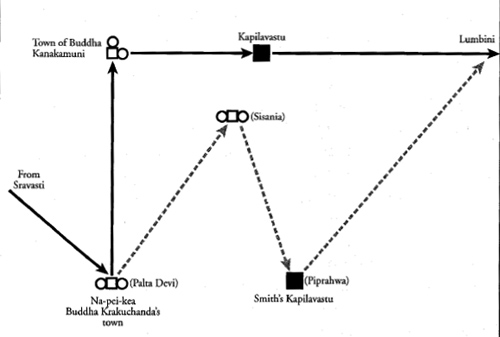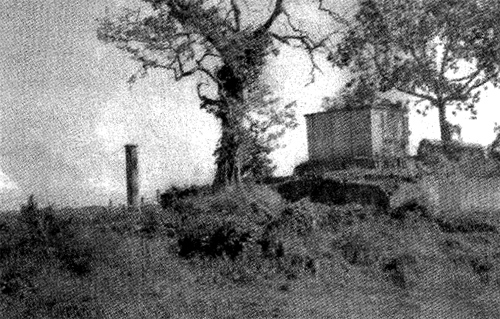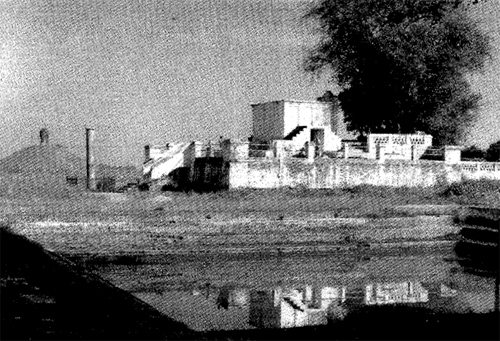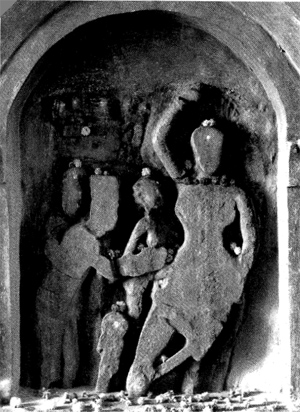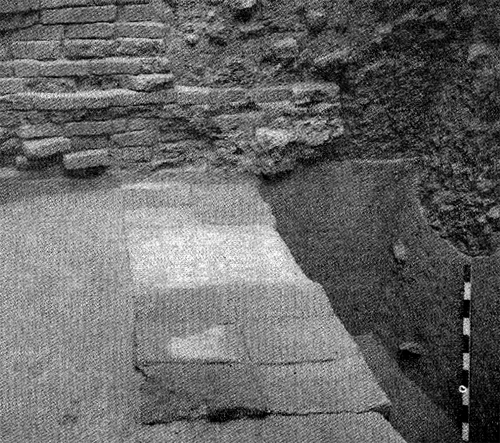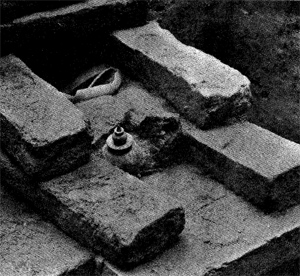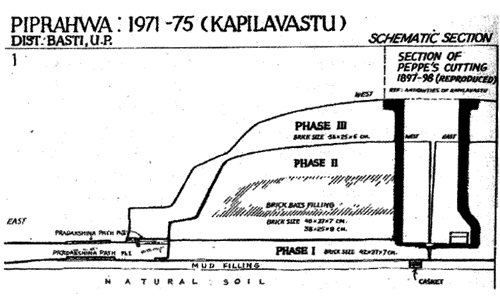No one at the time could have imagined how this brief visit to Piprahwa Kot and Birdpore House by the Archaeological Surveyor of the NWP&O would cast such a long shadow — over the finds themselves and over the lives of their finder and his descendants.
Less than a week after Dr. Fares visit to Birdpore Willie Peppe received an extraordinarily frank letter from Vincent Smith in Gorakhpur, dated 3 March. It began calmly enough, with thanks for the plans of the excavation that Peppe had made and what was probably a pencil-rubbing of the Piprahwa inscription, but then it developed into an extraordinary outburst against the Lieutenant- Governor of the NWP and Chief Commissioner of Oude (to give him his full title), Sir Antony MacDonnell. 'I am compelled to retire earlier than I had intended,' Smith wrote, The Lieut. Gov. by a D.O. [demi-official, meaning off the public record] letter to me dated the 23rd instant inflicted on me the public affront of cancelling my nomination to the Lucknow Bench, solely on the grounds that the Allahabad High Court wrote an angry letter objecting to my appointment: The High Court judge Sir John Edge had, it seems, written to the Lieutenant-Governor 'in a rage' because some months earlier Smith had gone against him and his fellow judges in a judgement on a matter of Hindu Law where Smith had followed a Privy Council ruling which Edge and his colleagues had chosen to ignore. For Smith his resignation was a matter of principle:
I have nothing to be ashamed of or retract, and I will not give way. I at once intimated to Govt that I should resign the service. Not a word of explanation was asked for, and I consider myself grossly insulted. The L. G. is full of expressions of personal regret but I have told him that these do not alter the fact that he has inflicted on me a public indignity which I will not submit to. He says that my retirement will be very inconvenient. I tell him I know it will but that the responsibility for this inconvenience does not rest with me. I have also told him that I intend to appeal to the Viceroy, and to press my resignation which he says he will oppose. I expect the L.G.s final answer in a day or two — so far all the correspondence is D.O.. I am angry at my treatment but for many private reasons glad to go. We are selling off all we can. With our kindest regards to you both.
It was a most indiscreet letter for a senior government official to have written, even if addressed to someone with whom he had evidently become quite close. But it also revealed Smith's volatile nature and the stress he was evidently under at the time. He had done more than his share of bread-and-butter district postings and felt he had earned his promotion to the Lucknow judicial bench as a senior judge. But there were also other issues on his mind, not the least of which were growing concerns about Dr. Anton Alois Fuhrer and some of his actions.
About a month earlier, in early February 1898, Hofrat Doktor Johann Georg Buhler, Professor of Indian Philology and Archaeology at the University of Vienna, had received a package from India. It was from his former student and close collaborator on early Indian texts, Dr. Fuhrer, and contained a somewhat crude hand-copy on a scrap of paper of an inscription found on the cover of a steatite vase, recovered from a stupa excavated by an 'English' planter in British territory close to the Nepalese border.
Unsatisfactory though this copy was, Buhler felt confident enough to attempt a preliminary reading until such time as a more accurate copy of the inscription could be obtained. Like so many epigraphists since, he was baffled by the three letters that spelled out su ki ti or su kri ti. Nevertheless, his was a reading that has stood the test of time:
This relic shrine of the divine Buddha (is the donation) of the Sakya Sukiti-brothers, associated with their sisters, sons and wives.
On 21 February Buhler sent copies of his translation to Fuhrer and Peppe, together with a letter to the latter giving his assessment of the significance of the Piprahwa inscription. He considered it to be 'the first historical document found which proves that the Sakyas, men belonging to the Buddha's tribe of Rajputs, resided in the neighbourhood of Kapilavastu after his death'. He went on:
It is not improbable that the stupa excavated by you, as the relic vase was dedicated by the Shakyas, belongs to those erected soon after the Nirvana [Maharaparinirvana]. If that is the case the inscription is the earliest document yet found in India. And it is remarkable that its alphabet differs from that used in the edicts of Asoka by the absence of the signs of the long medial vowels, though the letters agree in other respects.
As might be expected, Prof. Buhler had noticed that something was wrong with Peppe's hand-copy and he went on to ask him to check the inscription again for 'any traces of the required i in the first word, of the medial i in the second and a vowel mark in the last syllable of Bhagavata'. As mentioned earlier, Peppe had indeed missed the triangle of three dots representing the sound T at the very beginning and a second dot over the second letter. However, the inscription bore no vowel mark over the symbol representing the sound 'ta' in bhagavata (divine or blessed), an absence that suggested to the Professor that this was a very early inscription predating the Asokan edicts. He said as much in his 'Preliminary Note on a Recently Discovered Sakya Inscription; which he posted in mid-March to the Pali scholar T. W. Rhys Davids, Secretary of the Royal Asiatic Society in London, who arranged for it to be added to the April issue of the Journal of the Royal Asiatic Society.
Exactly what communications Buhler subsequently received from India over the next few weeks are largely a matter for conjecture. However, the following sequence events appear to have taken place.
On 24 February the Pioneer published Dr. Hoey's translation of the Piprahwa inscription based on his own pencil rubbing. This was not radically different from Miler's own reading, except in the matter of the rendering of su-ki-ti, so even if the Professor saw the notice he would have had no reason to feel he had been upstaged.
Far more relevant is the fact that on 23 March Dr. Fuhrer sent to the Secretary to Government, NWP&O, PWD, what he termed his 'preliminary brief report on the results of the Nepalese excavations in the Tarai conducted ... during the season of 1897-98: There is no shred of evidence that Professor Buhler received this 'preliminary report', but it would have been entirely uncharacteristic of Fuhrer not to have sent such a copy to his patron, particularly since Buhler had collected and sent on a comparatively large sum of money to fund his Nepal expedition. What is known for certain is that on 24 March 1898 Fuhrer sent a copy of this same report to General Khadga Shumsher Rana in Nepal. He accompanied it with a most unusual request 'with reference to a controversy lately carried on in the Indian newspapers regarding the discovery of Buddha's birthplace in the Nepal Tarai: This concerned Dr. Waddell's very public campaign to claim credit for that discovery, which had come to a head with the publication of Dr. Waddell's charges in the Journal of the Royal Asiatic Society. The correspondence pages of the January 1898 issue of the same journal had carried Fuhrer's rebuttal of Waddell's claims but also a further letter from Waddell that made additional charges, including the claim of plagiarism in Fuhrer's monograph Christian Tombs in the North-Western Provinces.
It is reasonable to speculate that after seeing this issue of the JRAS, which he would have received as a matter of course, Buhler wrote to his collaborator in India expressing his concern and asking for an explanation, hence Fuhrer's rather desperate appeal to General Khadga to set down what he remembered of his visit to the General's camp on i December 1896:
I will be extremely obliged if you will very kindly favour me with a few lines setting forth exactly what happened when I was privileged to pay you a visit on the 1st December 1896 at your camp at Padariyah, close to Rummindei [Lumbini]. You were kind enough to show me that pillar, and on seeing it, I told you on the spot that it was undoubtedly an Ashoka pillar and that an inscription would be found if a search was made below the surface of the mound. I am in need of it, as my antagonist, Dr. Waddell, has stated in the papers, 'It is somewhat amusing, after all Dr. Fuhrer has claimed in regard to this discovery, to find not only did he not initiate that research, but he had nothing to do with the local discovery of the spot, not even with the unearthing of the famous pillar-edict there, which fixed the spot beyond all doubt. This digging was done by the Nepalese officials in response to my letter to the Government of India.'
It also seems more than probable that when Fuhrer got back to Lucknow Museum from his Nepal excavations in mid-March he found waiting for him proof copies of his monograph Antiquities of Buddha Sakyamuni's Birth-Place in the Nepalese Tarai. This work was based on his earlier explorations of the Nepal Tarai in late November and December 1896 — the expedition during which the inscription on the Asokan pillar had been uncovered at Lumbini — but also included his earlier uncovering of the first Asokan pillar beside Nigliva Sagar in March 1895. Fuhrer had actually delivered the manuscript of his Antiquities to the Government Press in Allahabad as early as May 1897 and the book's type had been all set for printing when the order was given to take it off the press in order to make way for an official report on the 1896 famine, for which the same type was required. Fuhrer's manuscript had then been put to one side and seemingly forgotten by the printers. According to the Superintendent of the Allahabad Government Press, it was not until March 1898 that the printing of Antiquities was again taken in hand. The first printed copies were received by government departments at the end of July, which suggests that proofs may well have been available for Fuhrer to check in March. If that was the case, it again seems entirely reasonable to suppose that he would have sent a set of these proofs to Prof. Buhler in Vienna, particularly since Fuhrer had been at pains to thank Buhler in his Preface for his support of his work.
Antiquities of Buddha Sakyamuni's Birth-Place in the Nepalese Tarai was duly published as Volume XXVI of the Archaeological Survey of India's New Imperial Series and (confusingly) as Northern India Volume VI. It is a most bizarre document. In keeping with its precursors in the ASI series the monograph was expected to be a work of scholarship written by a scholar for scholars, setting out in accurate detail the results of an archaeological survey. What actually appeared in print was to all intents a Buddhist tract in nine chapters, seemingly written by a Buddhist for Buddhists. The lengthy first chapter was entirely taken up with the story of the Sage of the Sakyas, detailing his birth and early life up to his enlightenment, written in the most extravagant purple prose as, for example:
And when the Buddha, at the dawning of the day, had thus made the ten thousand worlds thunder with his attainment of omniscience, all these worlds became most gloriously adorned. And when thus he had attained to omniscience, and was the centre of such unparalleled glory and homage, and as many prodigies were happening about him as at his birth, he breathed forth that solemn utterance which had never been omitted by any of the Buddhas.
Chapter Two, entitled `Kshemavati, or Nabhika, the Birth-place of Buddha Krakucchanda', followed much the same Buddhist course — except for one paragraph describing how the author had located the several stupas of Buddha Krakuchanda thanks to the Chinese pilgrims. The third chapter, on `Sobhavati, the Birth-place of Buddha Konagamana' was slightly more objective. It included Fuhrer's detailed description of the Buddha Kanakamuni relic stupa rearing its imposing head close to the Asokan pillar beside Nigliva Sagar and the imposing ruins of Kapilavastu nearby.
Three brief but perfectly sensible chapters followed on Lumbini, Asoka's pilgrimage, and the two Asokan pillar edicts. Had Fuhrer confined himself to these three chapters his reputation as a scholar might well have survived. But they were followed by a chapter on `Kapilavastu, the Capital of the Sakyas; in which its author quoted extensively from 'the canonical books of the Southern Buddhists: Just eleven lines were devoted to the supposed site of Kapilavastu that the author claimed to have located and identified:
Thanks to the exact notes left by the two Chinese travellers, I discovered its extensive ruins about eighteen miles north-west of the Lumbini Pillar, and about six miles north-west of the Nigali Sagar, stretching between lat. 27°32'-38' N. [thus over a distance of nine miles] and long. 83°3'-10' E. [seven miles] in the middle of a dense sal forest over a length of seven miles from the villages of Amauli, Baidauli, Harnampur, and Bikuli (north-east) to Sivagarh, Tilaurakot, and Ramghat on the Banganga (south-west), and over a breadth of about three to four miles from the villages of Ramapura, Ahirauli and Srinagar on the south to the villages of Jagdispur and Nagravah on the north.
The Kapilavastu chapter was followed by a two-page essay on 'The Tharus, the modern descendants of the Sakyas, illustrated by four of the book's eight photographs. Wildly out of place though it was, this short anthropological study proposed a number of seemingly outlandish theories, two of which have since gained greater acceptance: 'The modern offspring of these Sakyas are probably the Tharus, the present inhabitants of the Tarai and the outer spurs of the Nepalese sub-Himalayas.... It is not quite improbable that they were in fact primarily an aboriginal, casteless and un-Aryan tribe of Northern India.' The sympathetic tone of the writing strongly suggests that Fuhrer identified with the Tharus as social outcastes.
The concluding chapter of Fuhrer's monograph capped all that had gone before. Entitled 'Historical conclusions', it was an opportunity for the author to summarise his work and findings. But the summary was cursory, the conclusions inconclusive other than the single challenging statement that the arrival of the supposedly exiled Sakyas in the hills 'forced them to develop the entirely non-Aryan and non-Indian custom of endogamy: The work ended rather as it had begun, with a long quotation from a Buddhist text in which the ascetic Vacchagotta addresses the Sakyamuni and compares his teaching to a mighty sal tree that looses all its dead branches, twigs and bark, and yet stands 'neat and clean in its strength. It is as if, oh Gautama, one were to set up that which was overturned; or were to disclose that which was hidden; or were to point out the way to a lost traveller; or were to carry a lamp into a dark place, that they who have eyes might see forms. Even so has Gautama Buddha expounded the Doctrine in many ways.'
It is hard to find a kind word to say about this extraordinary book. Either it was written by someone far out of his academic depth who resorted to padding on a grand scale, or it is the work of someone not quite in touch with reality, so desperate to see what Faxian and Xuanzang had seen centuries ago that he willingly suspended disbelief.
If the proofs of Antiquities were indeed received by Buhler in Vienna and read by him they must have troubled him greatly. And if Buhler ever got the opportunity to compare those proofs with Anton Fuhrer's 'preliminary brief report' on his most recent excavations in the Nepal Tarai he would have realised that his old student's claims to have discovered Kapilavastu — claims which he, Professor Georg Buhler, had fully endorsed and lauded in print — were bogus.
That 'preliminary brief report' was written in March 1898 as soon as Fuhrer got back to Lucknow. It contained two indisputable successes: Fuhrer's identification of Sagarwa lake as the site of the Sakya massacres visited by the Chinese pilgrims; and his identification of the Asokan column at the village of Gotihawa as the Buddha Krakuchanda memorial pillar seen by Xuanzang. But, crucially, what it never explained was where exactly the city of Kapilavastu was or what Fuhrer had found there. His impressive sounding map references — 'lat. 27°32'-38' N. and long. 83°3'-10' E: — meant that Kapilavastu city covered an area in excess of sixty square miles, not the twenty-eight that Ffihrer himself implied.
What Fuhrer's report also highlighted was that the copper reliquaries recovered from the seventeen Sakya stupas at Sagarwa bore the names 'of the following Sakya heroes, viz. Kundakumara, Junahakamara, Dhammapalakumara, Aljunakamara, Mahimsaasakumar, Yudhitthakurnar, Guttilakumara, Nandisena, Surasena, Sugaragutta, Aggidatta, Cetaputta, Giridanta, Sutasoma, Akitti, Lipananda, and Sabbadatta.'
These names, Fuhrer claimed, were 'for the most part engraved in pre-Asoka characters on the outside of the caskets, in two instances written in ink inside the lid, and in three cases they are carved in the bricks forming the relic chambers.' And as well as these seventeen inscribed caskets of the slaughtered Sakyas there was also the casket covered with an ornamented copper lid found in the ruined great stupa at Sagarwa, 'on which was incised in pre- Asokan characters the following: "Relics of the Sakya Mahanama", the successor to King Suddhodana of Kapilavastu.'
Despite the presence of a capable draftsman who produced accurate drawings of the stupas' bricks with their inscribed weaponry (see p. 109), and despite a camera on hand, Fuhrer's final report contained not a single drawing or photograph of any of these inscriptions. Fuhrer had made his claims knowing that the Nepalese Captain had confiscated all the caskets and that it was extremely unlikely that they would ever be seen again.
'If the alleged inscriptions had been found,' was Vincent Smith's subsequent comment, 'he would of course have photographed them. ... They were coated with verdigris (secured by oxidation) and no inscriptions on them could possibly have been detected without very careful cleaning. ... There can, therefore, be absolutely no doubt that the alleged inscriptions were absolute forgeries! In fact, Smith was wrong: these were not forgeries, which implies physical existence; they were plain lies.
Verdigris
Professor Buhler certainly received at least one communication from Fuhrer while the latter was still in Nepal. On 21 February he wrote from Zurich to Rhys Davids in England asking for his help over the word Sukitti or Sukiti, occurring on an inscription found by an English planter and sent to him by Fuhrer, adding that: 'The account, sent by Fuhrer, of the result of the Nepalese excavations at Kapilavastu and the neighbourhood is very good. Nothing must be said about it in public. He has been ordered to send a preliminary report ten days after his return: Fuhrer was back in Lucknow at the beginning of March, so that his preliminary report should have been completed by mid-March. If Prof. Buhler ever saw a copy of that preliminary report the sheer audacity of Fuhrer's claims to have found and read no less than eighteen pre-Asokan inscriptions must have set the alarm bells ringing. But, of course, there is no proof that Buhler did see it.
Nor, it must be said, is there any evidence to show that the Professor ever knew of the revelations concerning his protégé's dealings with the venerable Burmese pongyi or monk Shin U Ma.
On 2 February 1898 — that is to say, when Fuhrer was still deeply entrenched in his main dig at Sagarwa — the Government of Burma wrote to the Government of the NWP&O concerning complaints it had received from a monk named U Ma. These involved a certain Dr. A. A. Fuhrer, Archaeological Surveyor to the Government of the NWP&O. Shin U Ma had first taken the complaints to a local government official in Burma, Brian Houghton, and had then backed them up with tangible evidence in the form of letters received from Dr. Fuhrer. Houghton had duly passed U Ma's complaints and copies of his letters on to government headquarters in Rangoon, as a consequence of which they arrived on the desk of the Chief Secretary to the Government of the NWP&O, who passed them on to the Secretary of the Department of Revenue and Agriculture, Archaeology and Epigraphy. From there they made their way to the desk of the Commissioner of Lucknow.
As soon as he returned to his offices at the Lucknow Museum in early March Fuhrer was confronted with the communication from Burma and asked to explain himself. According to the file, his letters to the Burmese monk went back as far as September 1896, when he had written to U Ma about some Buddhist relics he had sent him, allegedly obtained from Sravasti. The contents of this first letter indicate that the two had met while the Burmese was on a pilgrimage to the holy sites in India and had struck up a friendship not unlike that described by Rudyard Kipling in his novel Kim (then in the process of being written in England), which begins with a wandering Tibetan lama being greatly moved by the knowledge of Buddhism shown by the Curator of the Lahore Museum (Rudyard's father J. L. Kipling).
Dr. Fuhrer and U Ma had then come to some arrangement for the one to send the other further relics. On 19 November 1896 Fuhrer wrote again to U Ma to say that:
The relics of Tathagata [Sakyamuni Buddha] sent off yesterday were found in the stupa erected by the Sakyas at Kapilavatthu over the corporeal relics (saririka-dhatus) of the Lord. These relics were found by me during an excavation of 1886, and are placed in the same relic caskets of soapstone in which they were found. The four votive tablets of Buddha surrounded the relic casket. The ancient inscription found on the spot with the relics will follow, as I wish to prepare a transcript and translation of the same for you.
This letter of 19 November 1896 was written more than a year after Fuhrer's first trip into Nepal made in March 1895 (during which he made his discovery of the Asokan inscription on the stump at Nigliva Sagar), but just before he set out on his second foray into Nepal (where he would meet up with General Khadga Shumsher Rana at Paderiya on 1 December 1896). Yet already, it seems, he had found Kapilavastu. In the year referred to in his letter — 1886 — he was still a relative newcomer to the NWP&O Archaeological Department and had yet to conduct his first excavation.
Fuhrer's next letter to U Ma was dated 6 March 1897, three months after his much trumpeted Lumbini and Kapilavastu discoveries. In it he referred to more Buddha relics in his keeping which he would hold on to until U Ma returned to India. Seven weeks later, on 23 June, there was a first reference to a 'tooth relic of Lord Buddha', and five weeks on, on 28 August, a further reference to 'a real and authentic tooth relic of the Buddha Bhagavat [Teacher, thus Sakyamuni]' that he was about to post to U Ma.
The letters now began to come thick and fast. On 21 September Dr. Fuhrer despatched 'a molar tooth of Lord Buddha Gaudama Sakyamuni ... found by me in a stupa erected at Kapilavatthu, where King Suddhodana lived. That it is genuine there can be no doubt.' The tooth was followed on 30 September by an Asokan inscription Fuhrer claimed to have found at Sravasti. Then on 13 December Fuhrer wrote to say that he was now encamped at Kapilavastu, in the Nepal Tarai, where he had uncovered 'three relic caskets with dhatus [body relics] of the Lord Buddha Sakyamuni, adding that he would send these relics to U Ma at the end of March. What is most odd here is that on 13 December 1897 Fuhrer had not yet entered the Nepal Tarai, having been given strict instructions that he was not to do so until 20 December.
This bizarre hoaxing — for no element of financial fraud seems to have been involved — could not go on. The arrival in Burma of the Buddha's molar tooth seems to have been too much for the hitherto credulous Burmese monk, who soon afterwards wrote what sounds like a very angry letter protesting at the remarkable size of the tooth in question. This letter was evidently forwarded from Lucknow to Basti and then probably carried by mail runner to Fuhrer's 'Camp Kapilavastu' at Sagarwa. It was replied to on 16 February 1898, when the Archaeological Surveyor was still encamped at Sagarwa. Writing at some length, Fuhrer went to great pains to mollify the Burmese, declaring that he could quite understand why `the Buddhadanta [Buddha relic] that I sent you a short while ago is looked upon with suspicion by non-Buddhists, as it is quite different from any ordinary human tooth' — as indeed it was, since it was most probably a horse's tooth — 'But you will know that Bhagavat Buddha was no ordinary being, as he was 18 cubits in height [18" x 18 = 27 feet] as your sacred writings state. His teeth would therefore not have been shaped like others: In a further bid to shore up the credibility of the tooth, Fuhrer went on to say that he would send U Ma —
an ancient inscription that was found by me along with the tooth. It says, 'This sacred tooth relic of Lord Buddha is the gift of Upagupta.' As you know, Upagupta was the teacher of Asoka, the great Buddhist emperor of India. In Asoka's time, about 250 BC, this identical tooth was believed to be a relic of the Buddha Sakyamuni. My own opinion is that the tooth in question is a genuine relic of Buddha.
This supposed Asokan inscription was afterwards found to be written in perfectly accurate Brahmi Prakrit, its most obvious models being the many similar relic inscriptions found at Sanchi and other Buddhist sites, with which Fuhrer was very familiar through his work on Epigraphia Indica.
It is highly unlikely that Fuhrer would have wanted his old patron to know about his troubles with the Burmese monk, and there is no surviving evidence to show that he or any one else wrote to Buhler about it. Yet the fact is that the file of the Fuhrer-U Ma correspondence was going the rounds of the concerned departments of the Government of the NWP&O in Allahabad in the spring of 1898. Because it touched on matters in Burma, which at that time came under the authority of the Government of India, it must also have been known and talked about in Government House, Calcutta. The professional opinions of senior members of the Asiatic Society of Bengal may well have been sought, the most respected among them being the editor of Asiatic Researches, the journal of the Asiatic Society of Bengal. This was the Swiss philologist Dr. Augustus Hoernle, a leading authority on early Central-Asian languages, who was at this time working on the decipherment of Khotanese texts written in Brahmi script (and whose own reputation was about to be badly dented by his acceptance of the forgeries of the notorious Islam Akhun of Kashgar, exposed by Aurel Stein in 1901). Philologists formed a tight circle and if Dr. Hoernle knew of the Fuhrer-U Ma correspondence, he may well have communicated his concerns to Vienna. Whether or not Dr. Hoernle was involved, it would have been surprising if whispers of the U Ma scandal had not reached London and Vienna by the end of March or the first week of April 1898.
As for Anton Fuhrer, nemesis was now fast approaching in the person of Vincent Smith, who corresponded with Dr. Hoernle in February and March while working with Willie Peppe on his article on the Piprahwa excavation for the Journal of the Royal Asiatic Society. No mention of the U Ma scandal can be found in the surviving correspondence of any of these parties, but there is just a hint of a growing desperation on the part of Dr. Fuhrer in a letter written by him to Willie Peppe on 31 March from Lucknow Museum. Fuhrer had been expecting him in Lucknow on the 26th, together with the Piprahwa stone coffer and its contents, but Peppe had not come and he had heard nothing from him:
The long looked for 26th March has come and gone, and lam sorry to say I had not the pleasure of seeing you here. If you are still coming do kindly allow me to prepare coloured drawings of all the objects found in your excavations. I shall be very happy to send a man to Birdpore on any day you mention, so that he could bring a part of the valuables here, in order to prepare an illustrated report. Or, if you do not mind, you could send the things by registered post (unpaid), and I shall return all objects with as little delay as possible.
But Peppe prevaricated, and a month later Fuhrer had still not received the promised relics. On 21 April he wrote again to Peppe to say that he would be 'glad to receive your relics in small instalments when ever you can spare them; adding that he had 'sent Prof. Buhler at Vienna copies of the photographs and a correct impression of the [urn?] inscription. He will send you soon a printed copy of [his article in the Journal of?] the Academy of Sciences at Vienna.' Thus suggests that when Fuhrer wrote this letter on 21 April he had not received any recent news from Vienna.
A few days later Fuhrer received a polite but firm letter from General Khadga Shumsher Rana in answer to his appeal for support against Dr. Waddell. The General agreed that he, Dr. Fuhrer, 'certainly had a good share in identifying the birthplace of Buddha' — but not the major role he had publicly given himself.
At this point, no doubt thoroughly fed up with all the public bickering that had long gone on between two government servants — Drs. Waddell and Fuhrer — the Lieutenant-Governor of the NWP&O himself stepped in to order that 'discussions of a controversial nature regarding claims to the merit of prior discovery' should be excluded from all future publications. As far as Sir Antony MacDonnell was concerned, 'Dr. Fuhrer's share in the discovery was confined to the deciphering of the inscriptions [on the columns at Lumbini and Nigliva Sagar],' and that was it.
As Anton Fuhrer's star began to fade so Vincent Smith's rose. In mid-March 1898, having refused to accept his resignation, the Lieutenant-Governor now offered him an immediate promotion to the post of Commissioner of Faizabad Division, to be taken up at the end of the year, and in the meantime a temporary 'acting' post as Chief Secretary to the Government of the NWP&O. This more than salved Smith's wounded pride and he accepted with alacrity. His promotion came with the additional bonus of a hot weather spent away from the open furnace of the plains in the cooling lakeside air of Naini Tal, in the foothills of the Kumaon Himalayas.
Just as Simla served as the summer capital of the Government of India so Naini Tal filled the same role as the summer capital of the Government of the NWP&O, an Elysium to which all the province's departments and headquarters staff migrated in mid-March, only returning to the plains in October. As acting Chief Secretary, Smith now found himself at the very centre of things, in direct touch with every senior government official in every department, and with the ear of the Lieutenant-Governor himself, Sir Antony MacDonnell.
Spoken of behind his back as 'our Fenian friend' because he was an Irish Catholic with nationalist sympathies, MacDonnell was a dedicated administrator but disliked and even feared by his more junior ICS colleagues on account of an ill-temper which he combined with a steely exterior. It was said of him by a friend that 'If Antony and another are cast away in an open boat and only one of them can live, it will not be Antony who is eaten'. These qualities had earned him the nickname of the 'Bengal Tiger' during his years in the Bengal secretariat and as acting Lieutenant-Governor of Bengal. A little later, Lord Curzon, as Viceroy, was to describe MacDonnell as 'a strange creature, by far the most able administrator we have in this country but .. destitute of human emotion' and regretted that 'so conscientious a worker and so able an official should not hit it off better with his own subordinates and should be, as is alleged, so suspicious and so severe towards any excepting the few whom he trusts among his own men'. Whether this was a fair assessment or not, it seems that in the case of his acting Chief Secretary the Lieutenant-Governor set aside his suspicious nature and came to rely on his judgement.
Anton Fuhrer also took to the hills. He had long been due some local leave, which he took in early April, although in his case it meant going by train with his family to the more distant but less expensive hill-station of Mussoorie. He was still on leave in Mussoorie when he heard of the distressing news from Vienna.

